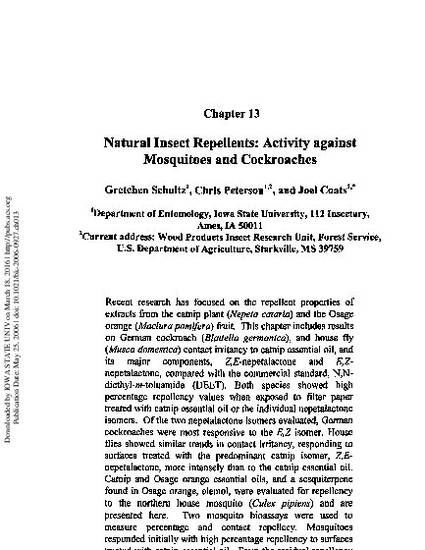
Recent research has focused on the repellent properties of extracts from the catnip plant (Nepeta cataria) and the Osage orange (Madura pomifera) fruit. This chapter includes results on German cockroach (Blattella germanica), and house fly (Musca domestica) contact irritancy to catnip essential oil, and its major components, Z,E-nepetalactone and E,Z-nepetalactone, compared with the commercial standard, N,Ndiethyl-m-toluamide (DEET). Both species showed high percentage repellency values when exposed to filter paper treated with catnip essential oil or the individual nepetalactone isomers. Of the two nepetalactone isomers evaluated, German cockroaches were most responsive to the E,Z isomer. House flies showed similar trends in contact irritancy, responding to surfaces treated with the predominant catnip isomer, Z,E-nepetalactone, more intensely than to the catnip essential oil. Catnip and Osage orange essential oils, and a sesquiterpene found in Osage orange, elemol, were evaluated for repellency to the northern house mosquito (Culex pipiens) and are presented here. Two mosquito bioassays were used to measure percentage and contact repellecy. Mosquitoes responded initially with high percentage repellency to surfaces treated with catnip essential oil. From the residual repellency study, this trend in repellency by the catnip oil significantly decreased over the 180-minute test period. Elemol, and DEET initially had lower percentage repellency values than catnip essential oil, but did not show the negative relationship between percentage repellency and time, retaining excellent repellency throughout the 3-hour bioassay. Solutions with elemol and DEET exhibited greater significance in contact repellency compared to catnip essential oil. These results show that catnip essential oil is a potent mosquito repellent, but does not provide the same residual effects as the commercial standard, DEET, Elemol, a sesquiterpene extracted from the fruit of the Osage orange, shows excellent promise as a mosquito repellent with comparable activity to DEET in contact and residual repellency.
Available at: http://works.bepress.com/joel_coats/65/

Reprinted (adapted) with permission from Natural Products for Pest Management, 927(13); 168-181. Doi: 10.1021/bk-2006-0927.ch013. 2006 American Chemical Society.